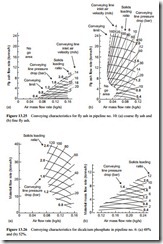Dicalcium phosphate
Dicalcium phosphate is another material that is recognized by its name and in this case different grades are identified by percentage references. A 48 per cent grade was used in the previous chapter as an example of a typical material having natural dense phase conveying capability. The conveying characteristics for the material conveyed through pipeline no. 6 (Figures 11.2 and 12.24) were presented in Figure 11.8a. They are repeated here in Figure 13.26a for reference.
Conveying characteristics for a 52 per cent grade of the same material are presented alongside in Figure 13.26b. Instead of using common axes for direct visual compari- son, different axes have been used this time in order to magnify the data for the dilute phase conveying case. As will be seen there is a 10:1 difference between the materials in terms of solids loading ratios. The 52 per cent grade could only be conveyed in dilute phase and the minimum conveying air velocity was about 12 m/s. That for the 48 per cent grade was about 11 m/s for dilute phase conveying, but as will be seen from Figure 11.9b, with higher pressures this was able to be reduced to about 4 m/s for the dense phase conveying of the material.
